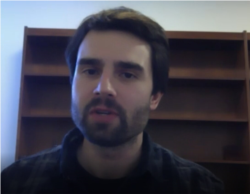Student Union
Student Debtor Forgiven $220,000 in School Loans

A judge in bankruptcy court has ruled in favor of a law school graduate who asked to have more than $220,000 in student debt erased.
The case is notable because student debt is commonly thought to be unforgivable in bankruptcy cases, a lament of many students who leave college saying they are too financially burdened to advance the milestones of adulthood, like buying property or having children.
But borrower Kevin J. Rosenberg, 46, of Beacon, N.Y., asked the court to forgive his student debt because repaying the loans was impossible and created an undue hardship, the legal test of whether a debtor should be forgiven.
Rosenberg’s student debt commenced in 1993, when he enrolled as an undergraduate at the University of Arizona, according to court documents. After receiving a bachelor’s degree in history, he served in the U.S. Navy on active duty for five years.
He then attended Cardozo School of Law at Yeshiva University in New York from 2001 to 2004. His degrees were financed by student loans.
When he graduated from law school in April 2005, he consolidated his debts with a nonprofit corporation called Educational Credit Management Corp., (ECMC), owing $116,464 in principle on the loan amount before interest. But by November 19, 2019, the 3.38% interest rate expanded that loan debt to $221,385.
Rosenberg is among a small percentage of student debtors – 2% -- who owe most of the nation’s $1.7 trillion student debt. This group borrowed money to pay for expensive graduate school programs, like law and medicine.
The average loan debt for law school graduates in 2012 was between $84,600 and $122,158, according to the American Bar Association. Almost 70% of law school graduates in 2016 left with student debt, according to the National Center for Education Statistics.
ECMC -- a nonprofit lender organization headquartered in Minneapolis, Minnesota -- argued that Rosenberg did not meet the undue hardship standard. They cited his age (45), health, lack of dependents, two degrees, and law licenses in New York and New Jersey in their legal brief.“
Shortly after starting his first job as an associate attorney at a law firm, [Rosenberg] decided that practicing law was not for him, because he disliked working in an office and did not find the work interesting,” New Jersey attorney Kenneth Baum, who represented ECMC, wrote in his court brief.
"Thus, after leaving that job after only 2½ months, [Rosenberg], with the exception of a brief period of working as a part-time contract attorney on a project basis – which [he] likened to working as a paralegal – has not sought any employment in the legal profession and has no intention of ever doing so, despite the fact that opportunities abound for Plaintiff to make a very respectable living in the legal profession," Baum wrote.
Rosenberg was quoted in Yahoo Finance on January 12, saying, “First of all, I realized the whole job is sitting in the office by yourself. You can't be creative at all, but also that you either help people out or you make a good living -- you can't do both. And I kind of had a problem with that.”
But Rosenberg told VOA that his hardship was caused by the collapse in the bricks-and-mortar retail industry in 2017, when a shop he owned in the Park Slope neighborhood of Brooklyn, New York City, failed because consumers made their purchases online.
"I left the law in 2005 and filed for bankruptcy in 2018," Rosenberg told VOA in email and by phone. "In between, I was able to launch a business as a street vendor and grow it into a small shop, and then with the help of an investor, a much larger shop that was nationally recognized, before brick & mortar retail collapsed in 2017. It was nation’s switch to ecommerce and the collapse of retail that directly caused my bankruptcy."
Judge Cecelia G. Morris, chief U.S. Bankruptcy judge in the Southern District of New York, agreed with Rosenberg. She used the student-debt test case, Brunner v N.Y. State Higher Education Services Corp., from 1987 differently than other decisions. “
Brunner has received a lot of criticism for creating too high of a burden for most bankruptcy petitioners to meet,” Morris wrote. For Brunner, who filed for bankruptcy within a year of graduation, “the test is difficult to meet,” she wrote. “
However, for a multitude of petitioners like Mr. Rosenberg, who have been out of school and struggling with student loan debt for many years, the test itself is fairly straightforward and simple," she said.
Rosenberg was relieved of his debt.
Student-loan experts say that most students are under the impression that student debt cannot be relieved in bankruptcy court. Some get bad advice from attorneys who also believe student debt cannot be forgiven in bankruptcy court. “
You can't discharge student loan debt in bankruptcy: That was the prevailing wisdom,” said Jason Iuliano, an expert in student debt and assistant professor of law at Villanova University in suburban Philadelphia.
But Iuliano, whose own student debt was hundreds of thousands of dollars after receiving degrees from Harvard University and Princeton University, dove into the caseload and found that wasn’t true. “
What I found when I actually went in and collected the cases was a lot of folks actually do meet the [undue hardship] test,” he said. “About 40% of the student loan debtors in bankruptcy … are successful in getting a discharge of some sort. And that struck me as really important.”
Iuliano said about 250,000 student debtors file for bankruptcy each year. But only about 500 of them take a necessary additional legal step – an adversary proceeding - to address college-loan specific debt. Only 1% end up going in front of a judge.
"A lot more people should be filing and trying to prove undue hardship, because they would be successful if they actually came before a judge,” Iuliano advised.
Ashley Harrington, senior policy counsel for the Center for Responsible Lending, celebrated the decision, but said student debt that impacts low-income and minority borrowers more than any others should be addressed long before debtors end up with interest-bloated loans. “
My initial thought was, ‘This is great, good for him.’ We’ve always supported student-loan discharge of both private and federal loans,” Harrington said. “But, there still is a need for Congress to do something about it.”
Among students in the Class of 2016, 70% borrowed an average of $30,000, Harrington said.“
People are really struggling under this debt for a very long time. Your repayment term is 20 to 25 years, and that’s as long as some people’s mortgages," she said.“
Part of the conversation is changing in judicial chambers because everyone is realizing what a crisis this is, seeing how it effects students’ lives,” Harrington added. “How much help have you given them?”
Rosenberg said he is frustrated by "some folks [who] come away acting like my case was a scheme to get out of a bad decision and it wasn’t.
"I did everything I could to avoid bankruptcy and tried to work things out with the lenders but they refused to budge ... I only filed for bankruptcy when I had no other realistic option."
ECMC has the right to appeal the decision. Spokesperson Laura Telander Graf emailed VOA that “We are reviewing the ruling to determine how we will proceed.”
See all News Updates of the Day
- By VOA News
Competition grows for international students eyeing Yale
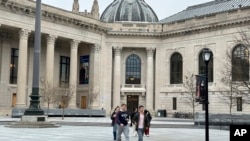
It’s tough to gain admission to Yale University, and it’s getting even tougher for international students as standout students from around the world set their sights on Yale.
The Yale Dale News, the campus newspaper, takes a look at the situation here.
- By VOA News
Student from Ethiopia says Whitman College culture made it easy to settle in

Ruth Chane, a computer science major from Ethiopia, writes about her experiences settling into student life at Whitman College in the U.S. state of Washington.
"The community at Whitman College made sure I felt welcomed even before I stepped foot on campus," she says.
- By VOA News
Claremont Colleges student gets a shock when she heads home to Shanghai

In The Student Life, the student newspaper for the Claremont Colleges, a consortium of five liberal art colleges and two graduate schools in Claremont, California, student Rochelle Lu writes about readjusting to her Shanghai home after spending a semester in the United States.
- By VOA News
Cedarville University aims to ease transition for international students

Cedarville University in the U.S. state of Ohio says it’s got more than 140 international students representing 44 countries.
Here, the school interviews Jonathan Sutton, director of international student services. He talks about his job and the opportunities for international students on campus.
- By VOA News
Morehouse College offers prospective students tips on applying and thriving

Morehouse College, a private, historically Black liberal arts college in the U.S. state of Georgia, offers a guide for international students interested in attending the school.
Among the tips to apply and thrive at Morehouse:
- Take advantage of the school’s orientation program
- Turn to the school’s Center for Academic Success for tutoring, support and more
- Immerse yourself in campus life via clubs and societies
- By Reuters
US reviews Columbia University contracts, grants over antisemitism allegations

The administration of President Donald Trump said on Monday it will review Columbia University's federal contracts and grants over allegations of antisemitism, which it says the educational institution has shown inaction in tackling.
Rights advocates note rising antisemitism, Islamophobia and anti-Arab bias since U.S. ally Israel's devastating military assault on Gaza began after Palestinian Hamas militants' deadly October 2023 attack.
The Justice Department said a month ago it formed a task force to fight antisemitism. The U.S. Departments of Health and Education and the General Services Administration jointly made the review announcement on Monday.
"The Federal Government's Task Force to Combat Anti-Semitism is considering Stop Work Orders for $51.4 million in contracts between Columbia University and the Federal Government," the joint statement said.
The agencies said no contracting actions had been taken yet.
"The task force will also conduct a comprehensive review of the more than $5 billion in federal grant commitments to Columbia University."
The agencies did not respond to requests for comment on whether there were similar reviews over allegations of Islamophobia and anti-Arab bias.
Columbia had no immediate comment. It previously said it made efforts to tackle antisemitism.
College protests
Trump has signed an executive order to combat antisemitism and pledged to deport non-citizen college students and others who took part in pro-Palestinian protests.
Columbia was at the center of college protests in which demonstrators demanded an end to U.S. support for Israel due to the humanitarian crisis caused by Israel's assault on Gaza. There were allegations of antisemitism and Islamophobia in protests and counter-protests.
During last summer's demonstrations around the country, classes were canceled, some university administrators resigned and student protesters were suspended and arrested.
While the intensity of protests has decreased in recent months, there were some demonstrations last week in New York after the expulsion of two students at Columbia University-affiliated Barnard College and after New York Governor Kathy Hochul ordered the removal of a Palestinian studies job listing at Hunter College.
A third student at Barnard College has since been expelled, this one related to the occupation of the Hamilton Hall building at Columbia last year.
Canada’s immigration overhaul signals global shift in student migration
From Europe to North America, nations are tightening their immigration policies. Now Canada, long seen as one of the world's most welcoming nations, has introduced sweeping changes affecting international students. The reforms highlight a growing global trend toward more restrictive immigration policies. Arzouma Kompaore reports from Calgary.
Trump administration opens antisemitism inquiries at 5 colleges, including Columbia and Berkeley

The Trump administration is opening new investigations into allegations of antisemitism at five U.S. universities including Columbia and the University of California, Berkeley, the Education Department announced Monday.
It's part of President Donald Trump's promise to take a tougher stance against campus antisemitism and deal out harsher penalties than the Biden administration, which settled a flurry of cases with universities in its final weeks. It comes the same day the Justice Department announced a new task force to root out antisemitism on college campuses.
In an order signed last week, Trump called for aggressive action to fight anti-Jewish bias on campuses, including the deportation of foreign students who have participated in pro-Palestinian protests.
Along with Columbia and Berkeley, the department is now investigating the University of Minnesota, Northwestern University and Portland State University. The cases were opened using the department's power to launch its own civil rights reviews, unlike the majority of investigations, which stem from complaints.
Messages seeking comment were left with all five universities.
A statement from the Education Department criticized colleges for tolerating antisemitism after Hamas' Oct. 7, 2023, attack on Israel and a wave of pro-Palestinian protests that followed. It also criticized the Biden administration for negotiating "toothless" resolutions that failed to hold schools accountable.
"Today, the Department is putting universities, colleges, and K-12 schools on notice: this administration will not tolerate continued institutional indifference to the wellbeing of Jewish students on American campuses," said Craig Trainor, the agency's acting assistant secretary for civil rights.
The department didn't provide details about the inquiries or how it decided which schools are being targeted. Presidents of Columbia and Northwestern were among those called to testify on Capitol Hill last year as Republicans sought accountability for allegations of antisemitism. The hearings contributed to the resignation of multiple university presidents, including Columbia's Minouche Shafik.
An October report from House Republicans accused Columbia of failing to punish pro-Palestinian students who took over a campus building, and it called Northwestern's negotiations with student protesters a "stunning capitulation."
House Republicans applauded the new investigations. Representative Tim Walberg, chair of the Education and Workforce Committee, said he was "glad that we finally have an administration who is taking action to protect Jewish students."
Trump's order also calls for a full review of antisemitism complaints filed with the Education Department since Oct. 7, 2023, including pending and resolved cases from the Biden administration. It encourages the Justice Department to take action to enforce civil rights laws.
Last week's order drew backlash from civil rights groups who said it violated First Amendment rights that protect political speech.
The new task force announced Monday includes the Justice and Education departments along with Health and Human Services.
"The Department takes seriously our responsibility to eradicate this hatred wherever it is found," said Leo Terrell, assistant attorney general for civil rights. "The Task Force to Combat Anti-Semitism is the first step in giving life to President Trump's renewed commitment to ending anti-Semitism in our schools."
- By VOA News
STEM, business top subjects for international students
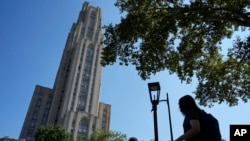
The Times of India breaks down the most popular subjects for international students to study in the U.S.
STEM and business lead the pack. Read the full story here. (January 2025)
- By VOA News
Safety and visa difficulties among misconceptions about US colleges

U.S. News & World report addresses some of the misconceptions about U.S. colleges and universities, including the difficulty of getting a visa.
Read the full story here. (January 2025)
- By VOA News
Work opportunities help draw international students to US schools
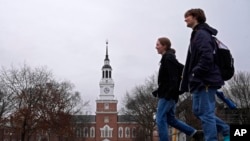
US News & World Report details the three top factors in foreign students' decision to study in the U.S. They include research opportunities and the reputation of U.S. degrees. Read the full story here. (December 2024)
- By VOA News
British student talks about her culture shock in Ohio

A British student who did a year abroad at Bowling Green State University in Ohio talks about adjusting to life in America in a TikTok video, Newsweek magazine reports.
Among the biggest surprises? Portion sizes, jaywalking laws and dorm room beds.
Read the full story here. (December 2024)
- By VOA News
Harvard's Chan School tells international students what to expect
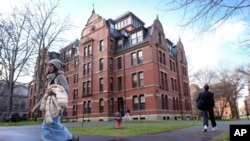
Harvard's T.H. Chan School of Public Health reaches out to international students by detailing the international student experience at the school.
Learn more about housing, life in Boston and more here.
- By Reuters
China unveils plan to build 'strong education nation' by 2035

China issued its first national action plan to build a "strong education nation" by 2035, which it said would help coordinate its education development, improve efficiencies in innovation and build a "strong country."
The plan, issued Sunday by the Communist Party's central committee and the State Council, aims to establish a "high quality education system" with accessibility and quality "among the best in the world."
The announcement was made after data on Friday showed China's population fell for a third consecutive year in 2024, with the number of deaths outpacing a slight increase in births, and experts cautioning that the downturn will worsen in the coming years.
High childcare and education costs have been a key factor for many young Chinese opting out of having children, at a time when many face uncertainty over their job prospects amid sluggish economic growth.
"By 2035, an education power will be built," the official Xinhua news agency said, adding that China would explore gradually expanding the scope of free education, increase "high-quality" undergraduate enrolment, expand postgraduate education, and raise the proportion of doctoral students.
The plan aims to promote "healthy growth and all-round development of students," making sure primary and secondary school students have at least two hours of physical activity daily, to effectively control the myopia, or nearsightedness, and obesity rates.
"Popularizing" mental health education and establishing a national student mental health monitoring and early warning system would also be implemented, it said.
It also aims to narrow the gap between urban and rural areas to improve the operating conditions of small-scale rural schools and improve the care system for children with disabilities and those belonging to agricultural migrant populations.
The plan also aims to steadily increase the supply of kindergarten places and the accessibility of preschool education.
- By VOA News
A look at financial aid options for international graduate students in US

The Open Notebook, a site focusing on educating journalists who cover science, has complied a list of U.S. graduate program financial aid information for international students.




